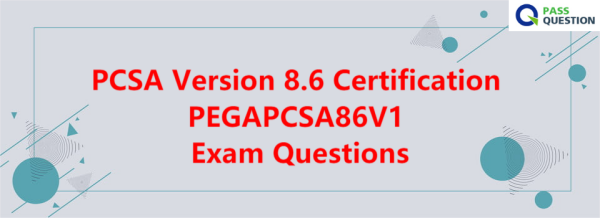PCSA Version 8.6 Certification PEGAPCSA86V1 Exam Questions
When preparing the PEGAPCSA86V1 Pega Certified System Architect (PCSA) 86V1 exam, The first thing you should remember is to memorize the PEGAPCSA86V1 core topics. You should memorize PCSA Version 8.6 Certification PEGAPCSA86V1 Exam Questions before you sit for real exam. PassQuestion provides real PCSA Version 8.6 Certification PEGAPCSA86V1 Exam Questions that cover all the aspects of the actual PEGAPCSA86V1 exam. This helps you a lot to crack the PEGAPCSA86V1 exam with a top scoring rate. It will also give you a clear idea to understand the real exam scenario and you will be able to improve your preparation for your exam. Make sure that you are using all of our PCSA Version 8.6 Certification PEGAPCSA86V1 Exam Questions various times so you can ensure your success when attempting Pegasystems PEGAPCSA86V1 exam.

Pega Certified System Architect
The Pega Certified System Architect (PCSA) Version 8.6 certification is for developers and technical staff members who want to learn how to develop Pega applications. This certification is the first level in the System Architect certification path and provides a baseline measurement on your knowledge of Pega applications. The PCSA Version 8.6 exam includes scenario questions, multiple choice questions and drag/drop items. If multiple answers are required, the text states how many responses are needed. The PCSA version 8.6 certification exam will be retired on September 30, 2022.
PCSA Version 8.6 Certification Path:
System Architect 8.6 mission
Exam Code: PEGAPCSA86V1
Type of Exam: 60 question exam
Length: 90 minutes
Passing Grade: 65%
Languages: English | French | German | Japanese | Portuguese-Brazilian
Exam Objectives
Case Management (28%)
Design a case lifecycle, stages, set case statuses, add instructions to tasks
Add a service level agreement; configure urgency, goals, deadlines, passed deadlines
Route assignments to users, work groups, work queues
Configure approval processes; cascading approvals, authority matrix
Configure and send email correspondence
Identify duplicate cases
Identify and add optional actions
Automate workflow decisions using conditions
Pause and resume case processing; wait steps
Skip a stage or process
Configure child cases
Understand when to use automation shapes
Automate decisions using decision tables and decision trees
Create and manage teams of users
Data and Integration (18%)
Configure data types, create data objects, data relationships, and field types
Identify and create calculated values
Validate data; create and configure data validation rules by using business logic
Manipulate application data, set default property values, configure data transforms
Access sourced data in a case; refresh strategies; populate user interface controls
Save data to a system of record
Simulate and add external data sources
Capture and present data; fields and views
View data in memory; clipboard tool, pyWorkPage
Security (7%)
Manage user and role assignments
Configure security policies
Track and audit changes to data
DevOps (7%)
Use unit test rules
Create and execute scenario-based test cases
Identify best practices for configuring unit tests
User Experience (16%)
Customize user interface elements, dashboards, portal content, configure action sets
Customize form appearance, visibility settings, controls
Add and remove fields
Group fields in views
Display list data in views; configure repeating dynamic layouts
Localize application content
Enable accessibility features in an application
Application Development (12%)
Manage application development; user stories, feedback, bugs
Use the Estimator to scope a Pega Platform project
Create and maintain rules, rulesets, classes, inheritance
Debug application errors
Reporting (7%)
Create business reports
Identify types of reports
Use columns and filters
Describe the benefits of using Insights
Mobility (5%)
Configure mobile app channels
Use of Pega Mobile Preview
- TOP 50 Exam Questions
-
Exam
All copyrights reserved 2025 PassQuestion NETWORK CO.,LIMITED. All Rights Reserved.

